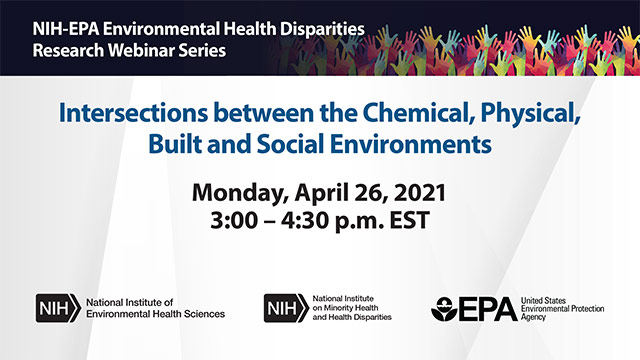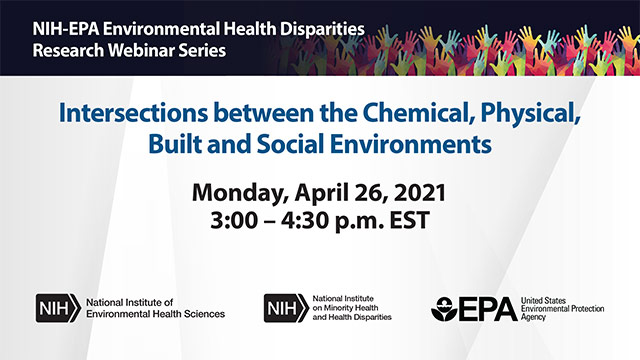Intersections Between the Chemical, Physical, Built and Social Environments
Moderators: Nadia Hansel, Professor of Medicine, Johns Hopkins University and Lindsey Martin, Health Scientist Administrator, Population Health Branch, NIEHS
| Time | Event |
|---|---|
| 3:00-3:05 p.m. |
Introduction of Presenters |
| 3:05-3:25 p.m. |
Dietary Interventions to Improve Respiratory Health in Low-Income Populations (1MB) |
| 3:25-3:45 p.m. | Modeling the Impact of Exposure Reductions Using Multi-Stressor Epidemiology, Exposure Models and Synthetic Microdata: A Case Study of Birthweight in Two Environmental Justice Communities (2MB) Center Affiliation: Center for Research on Environmental and Social Stressors in Housing Across the Life Course (CRESSH) Presenters: Chad W. Milando, Research Scientist, Boston University School of Public Health Maayan Yitshak-Sade, Assistant Professor, Icahn School of Medicine at Mount Sinai |
| 3:45-4:05 p.m. |
Health and Wellbeing Impact on Contamination of Traditional Foods and Water on the Navajo (2MB) |
| 4:05-4:30 p.m. |
Discussion and Questions & Answers |
NIH-EPA Environmental Health Disparities Research Webinar Series
Part 01 - Intro and Presentation #1

Part 02 - Presentation #2

Abstracts
Dietary Interventions to Improve Respiratory Health in Low-Income Populations
Investigators: Emily Brigham, M.D. M.H.S.1; Karina Romero, M.D.1; Han Woo, Ph.D.1; Kirsten Koehler, Ph.D.2; Nirupama Putcha, M.D. M.H.S.1; Nadia Hansel, M.D. M.P.H.1,2
1. Johns Hopkins University School of Medicine, Baltimore, MD, USA; 2. Johns Hopkins Bloomberg School of Public Health, Baltimore, MD, USA
Abstract: Low-income populations are disproportionately affected by environmental lung disease, including asthma and chronic obstructive lung disease (COPD). Etiology is complex, with multiple overlapping and interconnected factors. The Johns Hopkins EHD Center and others have contributed to the burden of proof for air pollution as a key factor in disparate outcomes for those living with asthma and COPD, and are working towards solutions to reduce personal exposures in the context of the indoor environment. In parallel, our group has provided evidence for the importance of diet quality, both as a primary factor in morbidity but also in modifying the response to air pollution exposures. Specifically, nutrients and patterns consistent with a healthful diet may provide benefit and protection, whereas those consistent with a poor or Western-style diet (highly prevalent in low income populations), may contribute to harm. Dietary interventions for respiratory health are few, and require special consideration within low-income populations for translation to sustainability. Access, availability of safe food storage, means for preparation, cost, convenience, cultural and individual preferences, convenience, and support and motivation for behavior change are integral to the enduring success of a program. Low-touch options are particularly attractive given present infectious concerns and indeed annually during viral season. Delivery services may provide an untapped opportunity to address (1) access, (2) customization, and (3) potentially cost via institutional or government partnership with demonstrated health benefits. We recently completed a pilot intervention to increase intake of omega-3 rich foods in a low-income population with COPD, using Amazon Fresh services. Sixteen participants received a $50 food voucher for 4 weeks and were randomized (1:1) to the intervention arm (weekly dietary counseling to assist with ordering of omega-3 rich foods and to advise on food preparation) or control arm (weekly assistance to order food of their preference). At 4 weeks, participants in the intervention group as compared to the control group, in intention to treat analysis, reported a 4-fold increase in high-omega-3 rich fish and seafood intake (p=0.002) and had a 43% increase in plasma EPA+DHA levels. As Amazon Fresh expands its delivery area and accepts Electronic Benefits Transfer (EBT) cards for assistance, there is a high potential for sustainability should the intervention prove successful in a definitive study. This and other available, pre-existing food or meal delivery programs provide a unique and exciting tool to improve access and durably address dietary contributions to environmental health disparities. Further, insights into food access barriers and dietary solutions will inform efforts within other environmental interventions in low income communities.
Modeling the Impact of Exposure Reductions Using Multi-Stressor Epidemiology, Exposure Models and Synthetic Microdata: A Case Study of Birthweight in Two Environmental Justice Communities
Investigators: Chad W. Milandoa, Maayan Yitshak-Sadeb, Antonella Zanobettib, Jonathan I. Levya, Francine Ladenb, M. Patricia Fabiana
a. Department of Environmental Health, Boston University School of Public Health, 715 Albany St, Boston, MA, 02118
b. Exposure, Epidemiology, and Risk Program, Department of Environmental Health, Harvard T.H. Chan School of Public Health, 677 Huntington Ave, Boston, MA 02115
Abstract:
Background: Many environmental justice communities experience elevated exposures to a mixture of environmental and social stressors, with deleterious effects on health. Some multi-stressor epidemiological models account for these mixtures; however, using these models to assess benefits of exposure reductions requires comparable exposure and risk factor data that are often unavailable at the individual level or at high spatial resolution.
Objective: To leverage public data and novel simulation methods to estimate how modeled changes to environmental exposures influence the distribution of birthweight in two environmental justice communities in Massachusetts, US.
Methods: We created synthetic individual-level risk factor data for mothers and newborns leveraging tabulated public data from the US Census and Department of Health reports with combinatorial optimization (CO) software. Risk factor models were also built with Behavioral Risk Factor Surveillance System (BRFSS) data. We combined the resulting exposure estimates with a multi-stressor epidemiological model to estimate baseline birthweight distributions at a census tract level as well as changes in birthweight associated with simulated improvements in environmental exposures.
Results: By using a nested CO approach we were able to create geographically resolved (i.e. census tract) individual synthetic microdata for women who gave birth living in two environmental justice communities. Maps identified higher risk census tracts of risk factors and birthweight. The highest risk of lower birthweight was found for maternal racial/ethnic minorities with lower educational attainment, parity > 1, and utilization of government support. The benefit of nighttime noise reduction increased with risk of lower birthweight, while birthweight improvements associated with greenness and temperature improvements were similar for all at-risk groups.
Significance: The methods to create synthetic microdata and combine with multi-stressor exposure and epidemiological models can be used to identify neighborhoods at high risk for modeled health outcomes, assess cumulative risks, evaluate disparities, and compare impacts of localized public health interventions.
Health and Wellbeing Impact of Contamination of Traditional Foods and Water on the Navajo
Investigators: Jani C. Ingram, Ph.D., Jonathan Credo, Andee Lister, Tommy Rock, Ph.D.
Northern Arizona University - part of the Center for Indigenous Environmental Health Research at the University of Arizona
Abstract: During the mid-1900s, the United States was locked in a nuclear arms race with the former Soviet Union in an era known as the Cold War. In order to meet demands, uranium mines were dug across the Navajo Reservation in the Southwest United States. Although the Cold War officially ended in 1989, these abandoned uranium mines on the Navajo reservation have left a legacy of contamination that infiltrates all aspects of life on the reservation. Uranium is a known toxicant due to its properties as a heavy metal, and uranium mining has been suggested to exacerbate exposure to other elemental toxicants, such as arsenic. Current understanding of the extent of contamination on the Navajo lands is ill-defined. Our research team has worked to elucidate exposure to these toxicants through quantifying uranium and other toxic elemental contaminants in water and traditional food; specifically sheep raised on or near abandoned mine sites. Our research results are used to provide insights on environmental public policies on the reservation and to provide feedback on of the issue through community meetings. We have published peer-reviewed manuscripts on the water and sheep results as well as the use of Traditional Ecological Knowledge in our work. These results will be discussed in the presentation.


